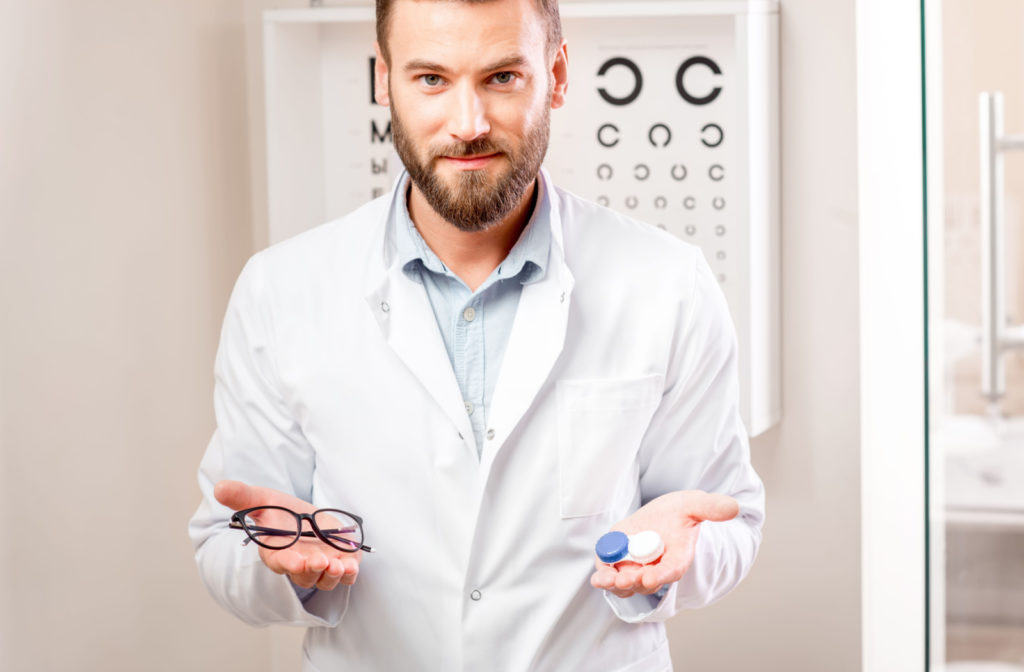Contact lenses are a popular vision correction option for many people. If you’ve worn glasses your entire life, you may already have an up-to-date prescription. However, you can’t simply grab the closest pair of contact lenses and expect them to work for you.
Glasses and contacts sit on your eyes differently, meaning they require different calculations for the prescription. If you’re getting contact lenses, an optometrist will need to ensure the power, curvature, and fitting information included in your prescription is correct.
Glasses Prescriptions Vs. Contact Lens Prescriptions
The prescriptions for glasses and contact lenses aren’t the same, primarily because people wear glasses and contacts differently. Glasses sit approximately 1 inch away from your eyes, while contacts sit directly on your eyes.
This means that the prescription for glasses needs a different calculation of how the lenses magnify and refocus the light that enters your eyes compared to contact lenses. Without the correct power, contact lenses may not effectively correct your visual impairment.
A prescription for contact lenses also needs additional information. While glasses need to fit your face, contact lenses need to fit your eyes like a glove. That’s why contact prescriptions include measurements such as the lenses’ curvature and diameter. For instance, if the curvature of the lens is too steep, it can create a poor fit on the eye which can cause discomfort and can even damage your cornea.
Types of Contact Lenses
Part of fitting your contacts is discovering the right type of lens for you. Not all contact lenses are the same, and understanding which type of contact lens is suitable for your eyes may significantly improve your vision, comfort, and overall eye health.
Soft Contact Lenses

Soft contact lenses are the most commonly used type of contact lenses and come in various materials, including hydrogel, silicone hydrogel, and others.
They’re generally more comfortable to wear, can provide excellent vision, and can come in daily disposable versions, meaning you can spend less time cleaning lenses.
Rigid Gas-Permeable (RGP) Contact Lenses
Rigid gas-permeable (RGP) contact lenses are made of a rigid, durable plastic material that allows oxygen to pass through the lens to the eye. They offer sharper vision than soft contact lenses and are more durable.
However, they require a more extended adaptation period and may not be as comfortable as soft contact lenses. You’ll also have to clean them since you’ll wear the same lenses day-to-day.
Hybrid Contact Lenses
Hybrid contact lenses combine the benefits of both soft and RGP contact lenses. They have a soft and comfortable outer skirt and a rigid center that can provide clear vision. Hybrid lenses can be an excellent choice for those with astigmatism or who have previously tried RGP lenses but found them uncomfortable.
Scleral Contact Lenses
Scleral contact lenses are large, rigid lenses that entirely cover your cornea, the eye’s clear front dome, but sit on the whites of your eyes. Since they vault over the cornea, they’re often used for those whose eyes need a bit more room to breathe. This includes people with severe dry eye, corneal irregularities, or keratoconus.
Scleral contact lenses are custom-made for each person’s eye shape and can provide the same clear and stable vision, but they require a longer adaptation period and can be expensive.
Toric Lenses
Toric lenses are specially designed contact lenses that can correct astigmatism. Astigmatism is a refractive error that occurs when the curvature of the cornea is more oval-shaped than spherical and causes distorted vision both at near and far distances.
Toric lenses have a unique shape that lets them rotate and keep the correct orientation on your eye.
Contact Lenses for Myopia Control
Myopia or nearsightedness is one of the most common vision problems in the world, and it’s increasing at an alarming rate. This makes myopia control a popular topic of discussion.
One of the most popular options for myopia control is MiSight contact lenses. These are daily disposable soft contact lenses for children and young adults designed to reduce myopia progression. MiSight lenses correct vision while also intentionally defocusing peripheral vision. By focusing light just in front of the retina, MiSight lenses cue the eye to stop growing, slowing myopia progression by up to 59%.
What Happens During a Contact Lens Fitting?
The first step in a contact lens fitting is to examine your eyes to determine their health and shape. Your optometrist can use different tools to get a thorough understanding of your eyes, including a keratometer to measure the curvature of your cornea. They may also measure your pupils using a slit lamp to help you get the correct size of contact lenses.
After examining your eyes, your eye doctor can recommend the type of contact lens that suits your needs. Once you decide on the type of lens, you may need to try on different trial lenses. This not only helps determine the right size of the lens, but it also helps test how comfortable the lens is, and if there are any fitting issues.
Your optometrist can finish a fitting by evaluating how the lenses’ sit on your eyes to check that they don’t move around too much. This is important as poorly fitting lenses can cause irritation, discomfort, and even long-term damage to your eyes.
Making the Move to Contact Lenses
While there are some similarities between contact lenses and glasses prescriptions, they’re not the same. Contact lens prescriptions require additional measurements and considerations to support a proper fit, and they include information about the type of contact lens and replacement schedule.Before making the switch from glasses to contact lenses, visit our expert team at LMC Optometry & Eye Care. We can fit your contacts and help you enjoy clear vision and comfortable wear. Book your eye exam today and ask about contact lenses!



